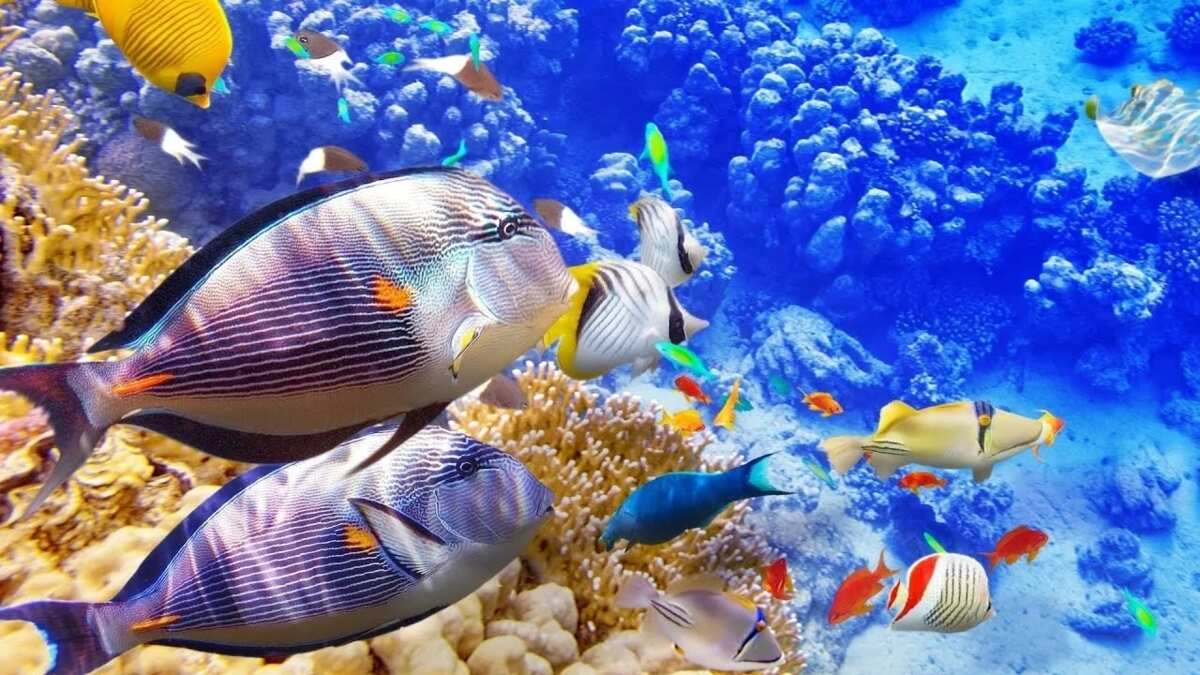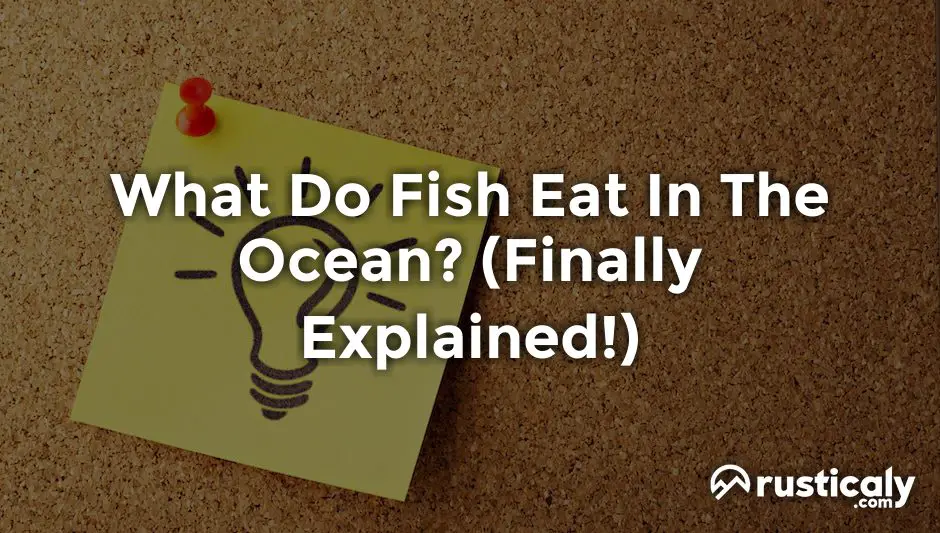What Fish Eat In The Ocean: A Deep Dive Into Marine Feeding Habits
Have you ever wondered what fish eat in the ocean? It’s a question that sounds simple, but the answer is surprisingly complex. The ocean is like a giant buffet, and fish have their own preferences when it comes to meals. From tiny plankton to larger prey, the feeding habits of marine life are as diverse as the creatures themselves. So, buckle up because we’re about to dive deep into the world of underwater dining.
Imagine swimming alongside a school of fish, watching them dart and weave as they hunt for food. It’s not just about survival; it’s about strategy, adaptation, and sometimes, sheer luck. Fish have evolved incredible ways to find and consume food, and understanding their diets can give us a glimpse into the delicate balance of marine ecosystems.
But why does it matter? Knowing what fish eat in the ocean isn’t just fascinating—it’s crucial for conservation efforts, sustainable fishing practices, and even our own diets. Whether you’re a marine biologist, a seafood lover, or just curious about the wonders of the sea, this article has something for everyone. Let’s get started!
Read also:Jasmine And Jeremy A Comprehensive Guide To Their Journey And Impact
Table of Contents
- Introduction
- The Marine Food Web: Who Eats Who?
- Plankton Eaters: The Tiny Feast
- Carnivorous Fish: Meat Lovers of the Sea
- Herbivorous Fish: Vegans Underwater
- Omnivorous Fish: The Ultimate Flexibility
- Scavengers: Nature’s Clean-Up Crew
- Predatory Behavior: How Fish Hunt
- Impact on Ecosystems: The Ripple Effect
- Conservation Efforts: Protecting Fish Diets
- Final Thoughts: What Can We Do?
The Marine Food Web: Who Eats Who?
The ocean is a vast and interconnected world where every creature plays a role in the food web. At the bottom of this pyramid are the primary producers, like phytoplankton, which form the base of the marine food chain. These microscopic organisms convert sunlight into energy through photosynthesis, providing sustenance for countless creatures.
As we move up the food web, we encounter zooplankton, small crustaceans, and other tiny organisms that feed on phytoplankton. These, in turn, become food for small fish, which are eventually consumed by larger predators. It’s a delicate balance, and any disruption—like overfishing or pollution—can have far-reaching consequences.
Key Players in the Marine Food Web
- Phytoplankton: The foundation of the food web.
- Zooplankton: Tiny creatures that graze on phytoplankton.
- Small Fish: Feed on zooplankton and other small organisms.
- Predatory Fish: Hunt smaller fish and other marine life.
Plankton Eaters: The Tiny Feast
Plankton-eating fish are some of the most fascinating creatures in the ocean. These fish, often small and delicate, rely on plankton as their primary food source. But don’t let their size fool you—these fish play a vital role in maintaining the health of marine ecosystems.
Some well-known plankton eaters include sardines, anchovies, and certain species of tuna. These fish are not only important for the ocean’s food web but are also a staple in human diets, providing essential nutrients like omega-3 fatty acids.
Why Are Plankton Eaters Important?
- They help regulate plankton populations.
- They provide food for larger fish and marine mammals.
- They contribute to the overall health of the ocean.
Carnivorous Fish: Meat Lovers of the Sea
When it comes to what fish eat in the ocean, carnivorous fish are the kings of the table. These predators feed on other fish, crustaceans, and even smaller marine mammals. Their sharp teeth and powerful jaws make them formidable hunters, and their diets are often high in protein and fat.
Examples of carnivorous fish include sharks, barracudas, and groupers. These fish are often at the top of the food chain, and their presence is a sign of a healthy ecosystem. However, overfishing and habitat destruction pose significant threats to these majestic creatures.
Read also:Exploring The Beauty Of Four Seasons Seoul Korea A Yearround Paradise
How Do Carnivorous Fish Hunt?
- They use speed and agility to catch prey.
- Some rely on stealth and ambush tactics.
- Others work in groups to surround and capture their meals.
Herbivorous Fish: Vegans Underwater
Not all fish are meat lovers. Some, like parrotfish and surgeonfish, prefer a plant-based diet. These herbivorous fish feed on algae and seagrass, helping to maintain the health of coral reefs and other marine habitats.
Herbivorous fish play a crucial role in preventing algae overgrowth, which can smother coral reefs and disrupt marine ecosystems. Their diets also contribute to the diversity of life in the ocean, as they create space for other organisms to thrive.
Benefits of Herbivorous Fish
- They help control algae populations.
- They promote coral reef health.
- They support biodiversity in marine ecosystems.
Omnivorous Fish: The Ultimate Flexibility
Some fish don’t limit themselves to just one type of food. Omnivorous fish, like clownfish and certain species of wrasse, enjoy a varied diet that includes both plants and animals. This flexibility allows them to adapt to changing conditions and find food in a variety of environments.
Omnivorous fish are often found in coral reefs, where they play a vital role in maintaining the balance of life. By consuming both algae and small invertebrates, they help keep the ecosystem healthy and thriving.
Examples of Omnivorous Fish
- Clownfish
- Certain species of wrasse
- Some species of damselfish
Scavengers: Nature’s Clean-Up Crew
Not all fish hunt for their meals. Some, like bottom-dwelling species, rely on scavenging to survive. These fish feed on dead or decaying matter, helping to keep the ocean clean and healthy. Scavengers play a crucial role in the nutrient cycle, breaking down organic material and returning it to the ecosystem.
Examples of scavenger fish include catfish, eels, and certain species of sharks. These fish may not be the most glamorous, but their work is essential for maintaining the health of marine environments.
Why Are Scavengers Important?
- They help remove organic waste from the ocean.
- They contribute to nutrient recycling.
- They prevent the spread of disease by consuming dead matter.
Predatory Behavior: How Fish Hunt
Predatory fish have developed a range of strategies to catch their prey. Some rely on speed and agility, while others use stealth and ambush tactics. Understanding how fish hunt can give us insight into their behavior and the challenges they face in the wild.
For example, sharks are known for their keen sense of smell, which allows them to detect blood from miles away. Barracudas, on the other hand, use their sharp teeth and lightning-fast movements to catch fish. Each species has its own unique approach to hunting, and these adaptations have evolved over millions of years.
Common Predatory Tactics
- Speed and agility
- Stealth and ambush
- Group hunting
Impact on Ecosystems: The Ripple Effect
The diets of fish have a profound impact on marine ecosystems. From regulating plankton populations to controlling algae growth, the feeding habits of fish influence every aspect of life in the ocean. However, human activities like overfishing and pollution can disrupt these delicate balances, leading to cascading effects throughout the food web.
For example, removing too many predators from an ecosystem can result in an overpopulation of smaller fish, which can lead to algae blooms and other environmental issues. Similarly, depleting herbivorous fish populations can cause algae to grow unchecked, smothering coral reefs and reducing biodiversity.
What Can We Do to Help?
- Support sustainable fishing practices.
- Reduce pollution and plastic waste.
- Protect marine habitats like coral reefs and seagrass beds.
Conservation Efforts: Protecting Fish Diets
Conservation efforts are crucial for protecting the diets of fish and maintaining the health of marine ecosystems. Governments, organizations, and individuals around the world are working to address the challenges facing our oceans, from overfishing to climate change.
Some effective conservation strategies include establishing marine protected areas, implementing fishing quotas, and promoting sustainable aquaculture practices. By working together, we can ensure that future generations have the opportunity to explore and enjoy the wonders of the sea.
Key Conservation Strategies
- Marine protected areas
- Fishing quotas
- Sustainable aquaculture
Final Thoughts: What Can We Do?
What fish eat in the ocean is more than just a question of survival—it’s a reflection of the intricate relationships that sustain life on Earth. By understanding the feeding habits of fish, we can gain a deeper appreciation for the complexity of marine ecosystems and the importance of protecting them.
So, what can we do? Start by making informed choices about the seafood you consume, supporting conservation efforts, and spreading awareness about the challenges facing our oceans. Every action, no matter how small, can make a difference in preserving the delicate balance of life beneath the waves.
Now it’s your turn. Leave a comment below and let me know what you think about fish diets in the ocean. Share this article with your friends and family, and let’s work together to protect the incredible world of marine life!


